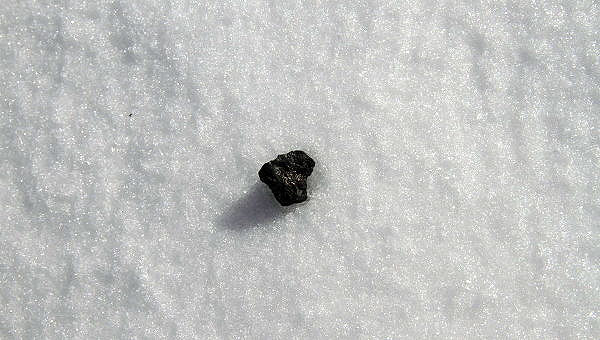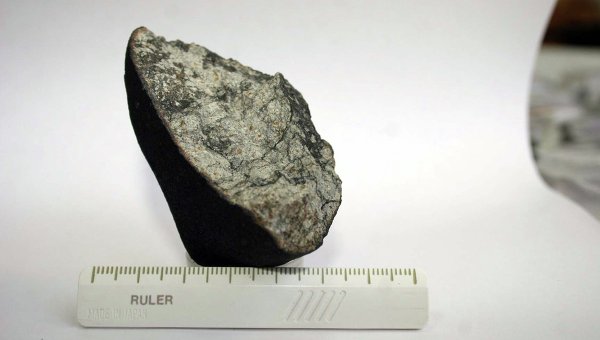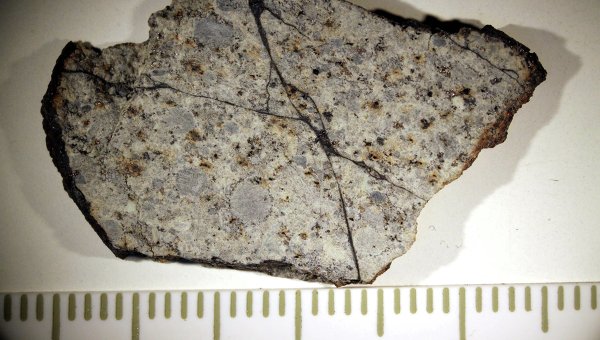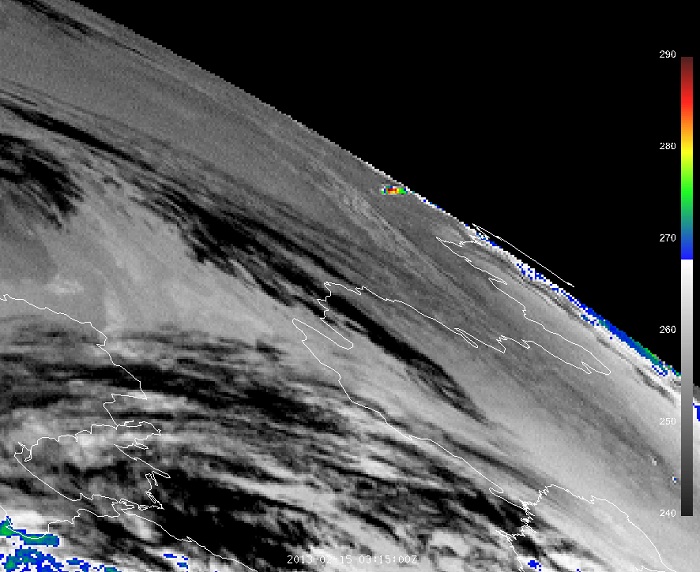A meteor broke apart over rural Russia on Friday morning, injuring at least 1,200 people. Hours later, an asteroid known as 2012 DA14 passed about 17,000 miles above Earth’s surface — a close shave in astronomical terms, passing nearer than many of our communications satellites. One was predicted; the other was not.
These events were unrelated, but they underscore how crucial it is that nations know, quickly, what is falling from the sky and what, if any, dangers are posed.
Every day about 40 tons of space debris hit the atmosphere, burn and settle to Earth, NASA has found. The vast majority of the detritus consists of meteoroids no larger than a grain of sand, but even tiny specks pack a wallop: A typical meteor hits Earth traveling at least seven miles per second, at least 30 times faster than a bullet shot from a handgun. That is why a tiny meteoroid can make such a spectacular shooting star.
According to the Russian Academy of Sciences, the meteor that disintegrated over Siberia on Friday weighed in the neighborhood of 10 tons. It was thought to be traveling at 10 to 12 miles per second when it broke apart.
Every year or so, such a meteor blazes through the sky somewhere over Earth. But every 100 years or so, Earth is hit by a meteor large enough to cause much more significant devastation. Such an impact occurred in 1908 in Tunguska, Russia, when a meteor 100 feet or so in diameter exploded in the Siberian wilderness, releasing about 1,000 times the amount of energy as the nuclear bomb dropped on Hiroshima.
And every 100 million years or so, Earth is hit by a meteor large enough to cause mass extinctions, like the one at the end of the age of dinosaurs. These threats are minuscule on a day-to-day basis, but surely any existential threat to the human race must be taken seriously.
To help get a handle on this danger, NASA coordinates the Near-Earth Object Program, which searches for and tracks asteroids and comets that could approach the earth. As of this week, about 10,000 near-Earth objects have been discovered, including nearly 900 with a diameter of roughly a kilometer or larger. None is expected to hit Earth anytime soon, but many large objects are believed to remain undetected.
In 2005 Congress set a 15-year deadline for scientists to find 90 percent of the near-Earth objects greater than about 500 feet in diameter — those large enough to cause regional or global devastation. But the mandate has been chronically underfunded. The project would require several more dedicated telescopes. Last year the project received about $20 million, far less than the $50 million that the National Research Council estimated in 2010 was needed to reach the congressional goal by 2030, a decade late. Even when this goal is met, most small asteroids and comets — too small to cause global devastation but still large enough to cause damage far worse than just occurred in Russia — will remain undetected unless funding is significantly increased.
Another danger is that even if a meteor does not itself cause major damage, any resulting chaos or confusion could lead nations to overreact. In 2002, for example, a meteor exploded over the Mediterranean at a time when India and Pakistan were facing off over the disputed Kashmir region. The U.S. Space Command’s deputy director for operations warned a congressionally mandated commission that the meteor might have been misidentified as a nuclear attack, had it come apart over South Asia.
Many countries lack the United States’ sophisticated sensors that can help determine whether a large explosion is nuclear in nature. The damage that could occur if a nation were to misidentify a meteor explosion and launch a counterattack is chilling. Washington should do more to establish an international warning system that can provide credible, near-instant information to countries across the globe whenever a major explosion is detected.
More broadly, Congress should continue to invest in day-to-day disaster planning, including improving coordination among first-responders. Such investments would help us respond to relatively frequent events such as hurricanes or earthquakes, as well as infrequent events, such as meteor strikes and terrorist attacks.
When something explodes or falls from the atmosphere, the world needs to know what it is. Impacts like what occurred in Russia on Friday are certain to occur. We should make the investments necessary to track near-Earth objects and prepare for disasters of all kinds.
Quelle: The Washington Post
.
Update: 17.02.2013 / 14.30 MEZ
.
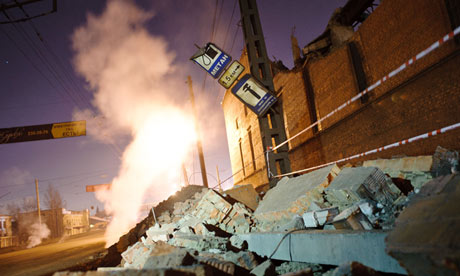
Russia scientists call for prevention after space rock blast
As officials hunt for pieces of the rock, scientists say the event over Chelyabinsk is a warning to implement a monitoring system to better detect celestial objects and avert catastrophes.
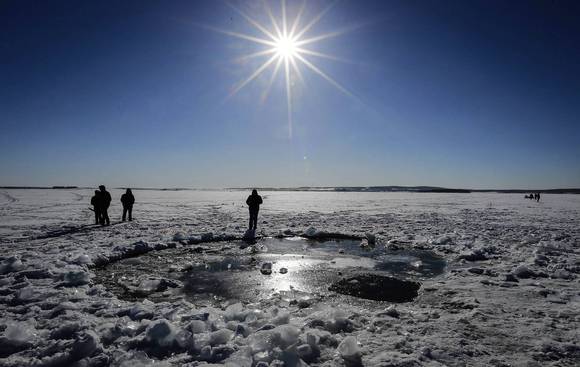
A large piece of the space rock is believed to have punched this hole in Chebarkul Lake, west of Chelyabinsk, Russia. Divers' initial search of the lake did not turn up any remnants of the object, which NASA called a "tiny asteroid."
-
As Russian authorities searched Saturday for remnants of the space object that startled residents of the southern Ural Mountain region a day earlier, scientists called its shock wave a loud warning that they hoped would inspire action to prevent potential catastrophes.
"When a small piece of rock would fall on the Earth 100 years ago, it could have caused minimal damage and would have stayed largely undetected, but Friday's accident fully demonstrated how vulnerable the technological civilization of today has become," Vladimir Lipunov, head of the Space Monitoring Laboratory with Moscow State University, said in an interview.
"It is high time for Russia to start heavily investing in building an advanced space danger monitoring and warning system, and above that, a system capable of destroying such super bombs falling on us from the skies," he said.
The scientist's remarks echoed concern displayed by government officials.
"Today neither Russia nor the United States is capable of shooting down objects from outer space," tweeted Dmitry Rogozin, vice premier in charge of the nation's defense industry.
What NASA described as a "tiny asteroid" wreaked havoc in the densely populated and highly industrialized Chelyabinsk region early Friday, its shock wave resulting in injuries to more than 1,100 people and causing millions of dollars in damage to buildings and disrupted phone and Internet communications.
The massive sonic boom damaged 3,000 houses, 34 hospitals and clinics, and 360 schools, as well as several businesses, officials said. At least three hockey games were canceled because of damage to the local rink.
Regional Gov. Mikhail Yurevich told reporters Saturday that damage exceeded $33 million but that 30% of the windows broken by the shock wave had already been replaced. About 20,000 municipal employees, emergency workers and volunteers worked around the clock to fix the windows in a region where the overnight temperature fell to minus-4 degrees.
Police have collected several small pieces of a black rock-like substance believed to be from the space object that broke apart as it exploded over the area, Interfax reported. Divers finished their initial inspection of Chebarkul Lake, about 40 miles west of Chelyabinsk, but found no traces of the object, a big chunk of which was believed to have fallen into the lake, breaking the thick ice.
The Chelyabinsk region has long been one of the most important military industrial regions of Russia, where you "can't drive a mile without passing a defense or a nuclear industry installation," Lipunov said.
"We should be thankful to fate that this meteor, in fact, was a blessing in disguise, and instead of destroying a significant part of Russia with quite dire consequences to the rest of the world, it sent us a clear warning signal by simply blowing up a bunch of windows and lightly injuring over 1,000 people," the scientist said.
Rogozin said that on Monday he would provide Prime Minister Dmitry Medvedev with proposals on possible ways to detect space objects approaching Earth and reduce the danger.
Lipunov said his monitoring system of four 15.7-inch telescopes deployed across Russia was able to produce a high-quality two-hour video of the 2012 DA14 asteroid, a much larger space rock that coincidentally passed close to Earth on Friday. But he said his lab could not discern smaller asteroids and meteors, which can also pose a grave risk.
Many Russian experts say that government funding for a monitoring system should be reinstated and that it should be equipped with 59-inch telescopes like those in the United States.
"Americans can, for example, detect a dangerous object and calculate that it can fall somewhere in the Urals, but that doesn't concern them," Alexander Bagrov, a senior researcher with the Astronomy Institute of the Russian Academy of Sciences, told Russia-24, a government news television network.
Bagrov spoke in favor of creating an early warning system of satellites monitoring space for signs of approaching danger, but Lipunov countered that a space-based system would be more expensive and could take a decade to install, and even then it would not be as reliable as an Earth-based system equipped with powerful telescopes.
In the meantime, residents of the region relived Friday's momentary panic and congratulated one another for surviving what they termed "the apocalypse."
"I am being bombed from outer space by some superior force," one user posted on his social media account, recalling his immediate reaction.
"It was a fantastic feeling how we were all united by our common [doom], as everybody was sharing with everybody else how scared he was," another user wrote.
"As these people were united in their horror and their panic on Friday in the Chelyabinsk region," said Lipunov, "so the governments of the most developed countries should unite in creating a system of warning and global protection from surprise attack from space."
Quelle: Los Angeles Times
.
YEKATERINBURG, February 17 - Over 24,000 workers and 4,300 pieces of equipment are involved in the effort to clear up the damage caused by a meteor that shook Russia’s Urals Region, the regional Emergences Center reported on Sunday.
A flaming meteorite streaked across the sky and slammed into central Russia on Friday with a massive boom that blew out windows and damaged thousands of buildings around the Urals city of Chelyabinsk, injuring more than 1,000 people in the area.
“As of 06:00 a.m. on Sunday, work has been done to replace window glass in 1,658 residential buildings, 34 health care organizations, 62 educational establishments and four social facilities. Window frames and glass have been restored on an area of 37,800 square meters. A total of 122 potential hazardous facilities have been inspected,” the Emergencies Center said.
The meteor blast, a rare and spectacular phenomenon, sparked confusion and panic among residents of the region and was captured by numerous witnesses on video that quickly spread to television and computer screens around the world.
Police and other officials said around 1,200 people had been hurt, including more than 200 children, mostly in the Chelyabinsk Region near the Ural Mountains. By the end of Friday, the number hospitalized was 50, according to the Emergencies Ministry. Earlier, at least two people were reported to be in "grave" condition.
The majority of those hurt had suffered cuts from broken glass, but the region's governor said two-thirds of the injuries were very light.
The blast was so powerful that it was detected by 11 of the 45 infrasound stations of the Comprehensive Nuclear Test Ban Treaty Organization (CTBTO)’s network designed to track atomic blasts across the planet.
"It was like a train falling down from the sky," a Chelyabinsk resident told RIA Novosti, adding that most people at first thought that a warplane had exploded above the city.
Quelle: RIANOVOSTI
.
Suche nach Meteoritenresten eingestellt
Die russischen Behörden haben die Suche nach Überresten des in der Nähe von Tscheljabinsk niedergegangenen Meteoriten eingestellt. Die Helfer sollen sich auf die Aufräumarbeiten konzentrieren.
Nach dem verheerenden Meteoritenschauer mit etwa 1200 Verletzten im Ural haben die russischen Behörden ihre Suche nach Überresten des Himmelskörpers am Sonntag eingestellt. Die im zugefrorenen Tschebarkul-See nahe der betroffenen Stadt Tscheljabinsk eingesetzten Taucher seien abgezogen worden, sagte ein Sprecher des Katastrophenschutzministeriums in Moskau. Die Taucher hatten dort nach Teilen des am Freitag niedergegangenen rund zehn Tonnen schweren Meteoriten gesucht. Ein Loch im Eis von etwa acht Metern Durchmesser sei aber offenbar nicht auf den Meteoriten zurückzuführen, sagte der Sprecher.
Den Ministeriumsangaben zufolge sollen sich alle Helfer nun auf die am Samstag begonnen Aufräumarbeiten in Tscheljabinsk konzentrieren. Über der mehr als eine Million Einwohner zählenden Stadt und der gleichnamigen Region war der Meteorit mit einem grellen Blitz und einer Druckwelle explodiert. Am Sonntag lagen weiterhin etwa 40 Menschen in Krankenhäusern.
Quelle: N24
.
Update: 18.02.2013
.
Wissenschaftler finden im Ural Meteoriten-Überreste
Hauptfragment auf Grund eines gefrorenen Sees vermutet
.
Russische Wissenschaftler haben nach eigenen Angaben Teile des Meteoriten gefunden, dessen Explosion im Ural schwere Schäden angerichtet und rund 1200 Menschen verletzt hatte. Nachdem die Behörden die Suche nach Fragmenten eingestellt hatten, verkündeten Mitglieder der russischen Akademie der Wissenschaften, sie hätten Meteoritenteile entdeckt. Die Forscher vermuten das größte Stück des Meteoriten auf dem Grund eines Sees.
Die in der Nähe des Tschebarkul-Sees in Zentralrussland gefundenen Gesteinsfragmente hätten "die Zusammensetzung eines Meteoriten", sagte der Expeditionsleiter Viktor Grochowski laut der Nachrichtenagentur RIA Nowosti. Der Stein habe einen Eisengehalt von schätzungsweise zehn Prozent, außerdem enthalte er Chrysolit und Sulfit.
Die Fragmente seien in Jekaterinburg untersucht worden, erklärte Grochowskis Ural-Universität auf ihrer Internetseite. Die Veröffentlichung war mit einem Foto versehen, auf dem jemand einen glänzenden schwarzen Stein zwischen Daumen und Zeigefinger hält. "Dieser Meteorit gehört zur Klasse gewöhnlicher Chondriten", hieß es in der Erklärung weiter. Chondriten bilden die mit Abstand häufigste Form der auf der Erde gefundenen Meteoritenteile.
Das Fundstück werde voraussichtlich "Meteorit von Tschebarkul" genannt werden, teilte die Universität mit. Die gefundenen Trümmer deuteten daraufhin, dass das Hauptfragment des Meteoriten auf dem Grund des Tschebarkul-Sees liege, sagte Grochowski der Nachrichtenagentur Interfax. Bislang seien im Schnee 53 Meteoritenteilchen gefunden worden, keines mehr als einen Zentimeter groß.
Taucher des russischen Katastrophenministeriums hatten am Wochenende unter einem etwa sechs Meter breiten Loch in der Eisdecke des Tschebarkul-Sees nach dem Meteoritenstück gesucht. Die Tauchgänge bei Außentemperaturen von minus 20 Grad endeten ergebnislos, die Suche wurde am Sonntag offiziell eingestellt. Es sei illusorisch, etwas in dem rund 1,5 Meter dicken Schlickgrund des Sees zu finden, sagte Katastrophenschutzminister Wladimir Putschkow.
Privatsammler boten am Wochenende in Internetanzeigen bis zu 300.000 Rubel (rund 7500 Euro) für Teile des Meteoriten. Die Behörden riegelten deshalb das Einschlagsgebiet ab und ließen weder Medienvertreter noch auf eigene Faust recherchierende Wissenschaftler zu dem Einschlagsloch auf dem See vor. Zudem ermittelte die Polizei nach eigenen Angaben gegen Verkäufer gefälschter Meteoritenteile.
Als der Meteorit am Freitagmorgen über der mehr als eine Million Einwohner zählenden Stadt Tscheljabinsk und der gleichnamigen Region mit einem grellen Blitz und einer Druckwelle explodierte, barsten unter anderem zahlreiche Fensterscheiben. Fast 5000 Gebäude wurden beschädigt. Mehr als 24.000 Katastrophenschutzmitarbeiter und Freiwillige waren am Wochenende im Einsatz, um zerstörte Fenster zu ersetzen.
Nach Angaben der örtlichen Behörden wurden 1240 Menschen, darunter fast 300 Kinder, durch die Folgen des Meteoritenschauers verletzt. Das russische Gesundheitsministerium sprach am Montag von rund 1500 Verletzten. Wissenschaftler der US-Weltraumbehörde NASA gehen davon aus, dass die in der Atmosphäre freigesetzte Energie der Meteoritenexplosion vom Freitag etwa 30 Mal höher war als die Sprengkraft der Atombombe von Hiroshima.
Quelle: Die Welt
.
Das ist ein Teilchen von Russlands Meteorit
Moskau - Erste Teilchen des über Russland abgestürzten Meteoriten sind nach Angaben von Experten gefunden. Einen Namen hat der Brocken aus dem All jetzt auch.
.
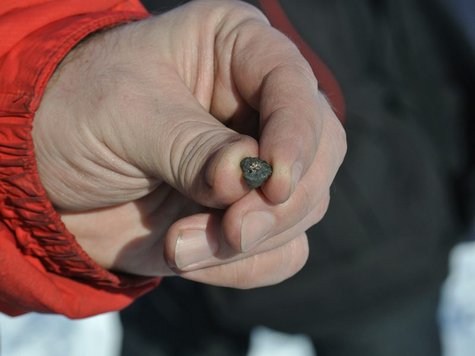
Russische Forscher haben erste Teilchen des Meteoriten gefunden, der etwa 1200 Menschen verletzt hat.
Nach dem Meteoriten-Einschlag in Russland mit etwa 1200 Verletzten haben Forscher angeblich Fragmente des Himmelskörpers gefunden. Tests hätten ergeben, dass es sich um echte Meteoritenteile aus dem Weltall handele, sagte Viktor Grochowski von der Universität in Jekaterinburg am Montag einer Mitteilung zufolge. Wissenschaftler hätten rund um den Tschebarkul-See bei der Stadt Tscheljabinsk insgesamt 53 Teilchen entdeckt, die alle nur wenige Millimeter groß seien. Die Behörden hatten die Suche am Vorabend eingestellt.
Die Überbleibsel bestünden zu bis zu zehn Prozent aus metallischem Eisen, außerdem aus dem Mineral Olivin und Sulfite-Salzen. „Das ist ein klassischer Chondrit, eine der verbreitetsten Meteoriten-Arten“, sagte Grochowski. Der Fund solle „Meteorit von Tschebarkul“ heißen. Der Himmelskörper war am Freitag am Ural auf die Erde gerast. Dabei waren auch etwa 5000 Gebäude beschädigt worden.
Bei Temperaturen um minus 20 Grad Celsius gingen in der Großstadt Tscheljabinsk die Aufräumarbeiten weiter. Alle Krankenhäuser und Schulen hätten geöffnet, teilten die Behörden mit. Viele Fenster waren noch mit Holz abgedichtet. Wegen der großen Nachfrage werde das Glas knapp, berichtete die Zeitung „Kommersant“. 46 Verletzte, darunter 3 Kinder, lagen noch in Kliniken.
Quelle: Merkur Online
.
Update: 19.02.2013
.
Chelyabinsk meteorite fragments are already on sale on one of the most popular online auctions, Ebay.
Not only the citizens of Russia are among the vendors but also Americans are involved.
A resident of St. Petersburg has advertised the sale of a black stone nearly the size of a man's palm which he says is part of the meteorite which blasted down from the heavens on February 15. The item has been declared open for auction with the current bid standing at $1,125.00.
According to reports from the Ministry of the Interior in the Chelyabinsk Region, the police are monitoring the Internet sale of pieces of the meteorite which crashed in the Urals.
Over the past few days many different sites have appeared offering the sale of meteorite fragments at prices starting at R10,000 and going all the way up to half a million rubles.
Chelyabinsk meteorite ‘made close shave with airliner’
It has just transpired that the Chelyabinsk meteorite that struck on Friday made a close shave with a Bombardier CRJ-200 airliner, as it was making a landing approach to Chelyabinsk Airport. The pilot, Captain Alexander Arkhipov, of Ak Bars Airlines, says he felt the heat and observed the heavenly intruder breaking up into several fragments.
He also says that on the videos shot from the ground the meteorite looks very different.
His plane landed safely and on time.
Scientists explained why telescopes could not see the Chelyabinsk meteor
Astronomers could not trace the Chelyabinskmeteorbecause this celestial body was approaching from the Sun, and telescopes did not see it in the sunshine, Deputy Director of the Sternberg Astronomical Institute at the Moscow State University Sergei Lamzin said.
"It was impossible to detect it, because it was flying fromthe Sun. But if it was flying at night, our MASTER telescopes’network could have traced it", Lamzin said to journalists.
MASTER telescopes can observe bursts in the Universe, watch comets, meteors and space debris. The system includes telescopes, located in the Tunka valley, Moscow region, Kislovodsk, in the Urals and in Blagoveschensk.
In the period of time around the fall of the Chelyabinsk meteor, the Russian Meteor weather satellite registered an increase in the concentration of water molecules in the orbit that possibly indicates that the space "guest" was a comet.
Meteorite rush seizes Russia
Scores of online bargain deals have spawned all over the Internet following the Friday meteorite crash in central Russia’s Chelyabinsk, with many opportunities grabbing at the change of making easy profits from auctioning off what they claim to be fragments of the genuine meteor.
Some sellers were reportedly asking as much as $4,000 per piece over the weekend, as the meteorite rush reached its peak. Many vendors claimed they either worked at the sites devastated by the meteorite that burst to pieces over the Russian city on Friday or came to possess the precious bits of space rock through trading with the locals.
One of the sellers wrote that he got his 263-gram fragment from the Chelyabinsk zinc factory rubble and described how it smelt of sulphur, while another claimed he had carried off a 200-kilo rock from the impact site near a Chelyabinsk lake.
Researchers say the meteorite exploded into at least seven large pieces and hundreds of small ones. One of the bigger fragments plunged into the local Chebarkul Lake, forming an 8-meter ice hole.
Most of meteorite mass sunken in Lake Chebarkul - scientists (VIDEO)
Most of the meteorite that fell over the Chelyabinsk region on Friday morning and fragments of which Urals Federal University scientists have found is sunken in the Lake Chebarkul, expedition leader, member of the Russian Academy of Sciences Meteorite Committee Viktor Grokhovsky told Interfax on Monday.
"The fragments discovered come from the meteorite fusion crust, which means most of the meteorite mass is sunken in the lake," he said. The expert estimated the size of the sunken meteorite at 50-60 centimeters.
"We have found tiny pieces, about 50-53 in all, and each is measured in millimeters. That was all we could find in the snow around the crater," he said.
New expeditions of Urals scientists to the meteorite drop zone are in question: scientists lack funds and there has been no official order for their work. "It was our personal initiative. Being a committee member, I could not have stayed aside so I sent the guys there," Grokhovsky said.
The search zone will be very wide, he said. Grokhovsky predicted that meteorite fragments might be found not only in the Lake Chebarkul. University specialists are preparing for detailed analysis of the fragments. They have identified the meteorite as a regular chondrite, a stone meteorite containing about 10% of iron.
Scientists confirm Chebarkul Lake meteorite found in Russian Urals as meteorite with an iron content of about 10%
Scientists have discovered in Lake Chebarkul fragments of the meteorite, which fell on Friday morning near Chelyabinsk. Their extraterrestrial nature has been corroborated by chemical analysis, reported member of the Russian Academy of Sciences’ Committee on Meteorites Victor Grokhovsky of the Urals Federal University.
Previously there was information that an expedition comprising Urals University staff had set out to Chelyabinsk tasked with finding fragments of the meteorite.
"We literally only just finished the studies, and confirm that the particles found by us in the vicinity of Lake Chebarkul are of meteorite nature. This meteorite is classified as a chondrite; it’s a stone meteorite with an iron content of about 10%. Most likely, it will be given the name Chebarkul meteorite," said Grokhovsky.
“All the medical, educational and social buildings have been restored. Studies at all children’s educational institutions in the Chelyabinsk Region will continue on Monday,” Rospotrebnadzor said in a statement.
.
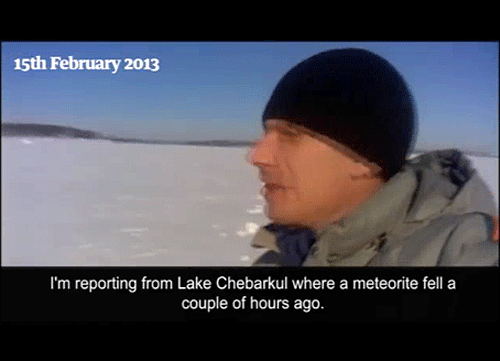
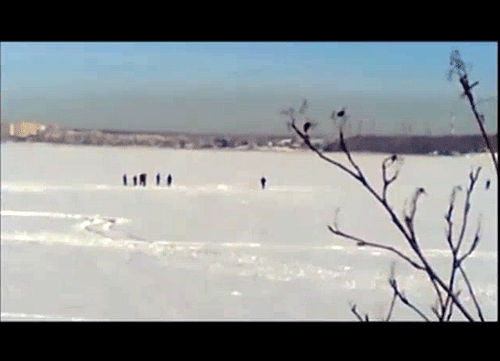

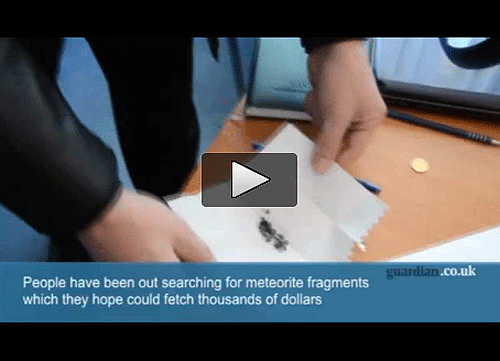

Frams: guardian-Video
,
Quelle: RIANOVOSTI
.
The first firm details of the 15 February asteroid impact in Russia, the largest in more than a century, are becoming clear. ESA is carefully assessing the information as crucial input for developing the Agency’s asteroid-hunting effort.
At 03:20 GMT on 15 February, a natural object entered the atmosphere and disintegrated in the skies over Chelyabinsk, Russia.
Extensive video records indicate a northeast to southwest path at a shallow angle of 20° above the horizontal. The entry speed is estimated at around 18 km/s – more than 64 000 km/h.
According to calculations by Peter Brown at the University of Western Ontario, Canada, drawing on extremely low-frequency sound waves detected by a global network, the object is estimated to have been about 17 m across with a mass of 7000–10 000 tonnes when it hit atmosphere.
It exploded with a force of nearly 500 kilotons of TNT – some 30 times the energy released by the Hiroshima atomic bomb – around 15–20 km above the ground.
With our current understanding of near-Earth objects, events of this magnitude are expected once every several of tens to 100 years.
Nicolas Bobrinsky, Head of ESA’s Space Situational Awareness (SSA) programme, and Detlef Koschny, responsible for the programme’s Near-Earth Object activity, responded to questions about the event.
Was this event related to the predicted flyby of asteroid 2012 DA14, which passed Earth at 19:27 GMT that same day at just 28 000 km?
DVK: The trajectory, the location of entry into the atmosphere and the large time separation between the two events indicate that the Russian object was unrelated to 2012 DA14.
What caused the damage on the ground? Did pieces hit people or buildings?
DVK: Many media reported that an airburst caused window breakage and some structural damage in downtown Chelaybinsk. Normally, some damage begins to occur at around five times normal air pressure at sea level. Widespread window damage is expected around 10–20 times this value.
As the explosion and fireball progressed along a shallow trajectory, the cylindrical blast wave would have propagated directly to the ground and would have been intense.
The terminal part of the explosion probably likely occurred almost directly over Chelyabinsk. This was perhaps the single greatest contributor to the blast damage.
We are waiting for confirmation from the Russian authorities that pieces of the object – bits of meteorite – have been found in the region. We’re unaware of any media reports of anyone or any structure being hit by any debris from the object itself.
Quelle: ESA
.
Update: 22.02.2013
.
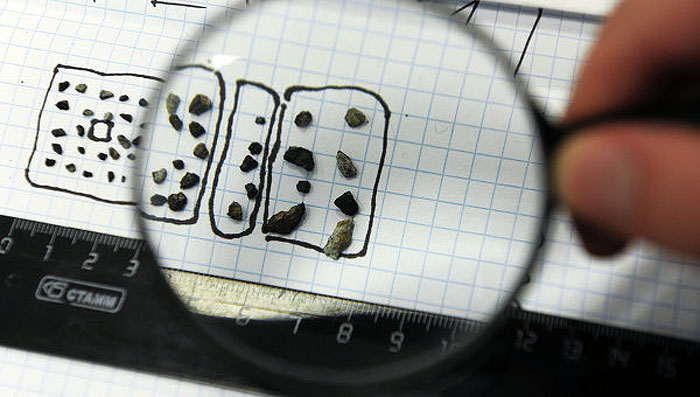
Meteorite Fragment Brought to Moscow
.
MOSCOW, February 21 – The first fragment of the meteorite which spectacularly crashed to earth in central Russia last week was delivered to Moscow for analysis on Friday.
“This is the first piece, but it’s not the only one our colleagues collected,” said Mikhail Nazarov, head of the science laboratory where the meteorite will be analyzed.
The scientists’ first tasks will be to weigh and photograph the fragment, he said. The laboratory will then carry out a detailed analysis of the meteorite, Nazarov added.
Over 1,000 people were injured when the massive meteorite streaked across the sky over the Russian city of Chelyabinsk on February 15.
NASA estimates the meteorite was roughly 50 feet (15 meters) in diameter when it struck Earth's atmosphere on Friday, travelling several times faster than the speed of sound, and exploded into a fireball brighter than the morning sun.
Fragments of the meteorite have been found in an eight-meter wide crater in the region’s Lake Chebarkul, scientists said earlier this week.
.
Twenty-five of the people hospitalized as a result of the meteorite that hit Russia last week have now been discharged, the local emergencies ministry confirmed on Friday.
“As of 07:00 hours on February 22, 2013, 25 people, including 11 children, were discharged from treatment centers,” the local emergencies ministry statement reads.
Windows were shattered and walls damaged by shockwaves in thousands of buildings, mostly residential, as the meteorite streaked through the sky over the Chelyabinsk Region on February 15. Over 1,500 people were injured, mostly by flying glass. Local officials say over 60 people were hospitalized.
The total bill for the damage is estimated at 1 billion rubles ($33 million). On Monday, Chelyabinsk Region asked Russia’s Federal Government for $16.6 million worth of aid to help repair damage caused by the meteorite.
To date, local emergencies ministry officials say that repairs have been carried out to over 4,000 buildings that had their windows blown out by the blast. Since this is a region of Russia in which temperatures are below freezing throughout winter, currently hovering around 10 degrees Fahrenheit, these repairs – especially to schools and homes – are vital.
Quelle: RIA Novosti
Legenden-Bildung geht weiter :
Nur die Hälfte der Russen glauben den Berichten über dem Meteoriteneinschlag in der russischen Ural-Region nahe Tscheljabinsk, heißt es in der Freitagsausgabe der „Nowyje Iswestija“ unter Berufung auf eine eigene Umfrage.
Der Rest der Umfrageteilnehmer ist der Ansicht, dass es sich entweder um einen Waffentest, um den Absturz eines Satelliten oder um die Ankunft von Außerirdischen handelt. Nach Ansicht von Soziologen glauben viele Russen, dass Pannen des Militärs immer noch verschwiegen werden, wie es häufig in der Sowjetunion der Fall war.
Dreimal so viele Befragte sind der Ansicht, dass es sich bei dem Vorfall um ein außerirdisches Raumschiffs statt um den Absturz eines Satelliten handelt. Für weniger glaubwürdig halten die Russen die Version über einen niedergegangenen Stern.
Einige der Befragten glauben an keine in der Umfrage angegebene Version. Vielleicht sind sie der Ansicht, dass die Explosion über dem Ural ein Vorbote für eine näher rückende Apokalypse, einen außerirdischen Energieknall bzw. eine Massen-Halluzination war.
Laut Meinungsforscher Alexej Graschdankin glauben vor allem ältere Russen nicht an die offizielle Version: „Die Menschen erinnern sich an die sowjetische Vergangenheit, als Pannen bei verschiedenen Tests verheimlicht wurden.“
Quelle: Ria Novosti
.
Update: 25.02.2013
YEKATERINBURG, February 25 (RIA Novosti) - Scientists from Russia's Urals Federal University have discovered a meteorite fragment weighing more than one kilogram (2.2 lbs), the largest found so far from the meteorite strike that hit the Urals region on February 15, University expedition chief Viktor Grokhovsky said on Monday.
A total of more than 100 fragments have been found by the expedition along a 50 kilometer (30 mile) trail under the meteorite's flight path, he said.
Over 1,500 people were injured and thousands of buildings damaged when the massive meteorite streaked across the sky over the Russian city of Chelyabinsk.
US space agency NASA estimates the meteorite was roughly 15 meters (50 feet) in diameter when it struck Earth's atmosphere, travelling several times the speed of sound, and exploded into a fireball brighter than the morning sun.
Fragments of the meteorite have been found in an eight-meter (25 feet) wide crater in the region’s Lake Chebarkul, scientists said earlier this week.
.
One-Kilo Meteorite Fragment Found
.
Quelle: RIA NOVOSTI
...
Update: 27.02.2013
Astronomen entdecken, woher Meteorit von Tscheljabinsk angeflogen kam
Kolumbianische Astronomen haben den Ursprung des Meteoriten festgestellt, der Mitte Februar über Zentralrussland explodierte.
Mit Hilfe von Amateuraufnahmen des fallenden Meteoriten konnten Wissenschaftler die Flugbahn des kosmischen Objekts durch die Erdatmosphäre bestimmen und dann seine Umlaufbahn im Sonnensystem rekonstruieren.
Die Forschung ergab, dass das gefallene Objekt der Abart von steinernen Meteoriten angehört hatte, die besser als Apollos bekannt sind, deren Umlaufbahnen die Umlaufbahn der Erde von außen kreuzen.
Offenbar drehte sich der Meteorit vor der Begegnung mit der Erde auf einer elliptischen Umlaufbahn um die Sonne.
RIA NOVOSTI
.
Moskau - Knapp zwei Wochen nach dem Meteoriteneinschlag in Russland haben Taucher mögliche Krater auf dem Grund des Tschebarkul-Sees gefunden.
.
Das gebe neue Hoffnung auf die Entdeckung der größten Teile des Himmelskörpers, sagte die Sprecherin der Stadt Tschebarkul, Ljubow Rudometowa, am Mittwoch der Agentur Itar-Tass zufolge. Eine etwa drei Meter dicke Schlammschicht am Boden erschwere die Suche. Ein Team um den Experten Viktor Grochowski aus Jekaterinburg will an diesem Donnerstag zu dem See aufbrechen, um die Nachforschungen fortzusetzen.
Die Druckwelle des am 15. Februar über Tscheljabinsk am Uralgebirge explodierten Meteoriten hatte rund 7000 Gebäude beschädigt. Durch berstendes Glas verletzten sich etwa 1500 Menschen.
Geplant sei nun, den Boden des Sees mit Spezialgeräten abzusuchen, sagte Grochowski. Er vermutet, dass das Hauptstück des Meteoriten in dem Gewässer liegt. Nach einer ersten Tauchexpedition am 16. Februar hatten die Behörden die Suche zunächst eingestellt. Damals hatte es geheißen, das gezeigte Loch im Eis habe wohl einen anderen Ursprung.
Die Forscher aus der Uralstadt Jekaterinburg hatten zuletzt mehrere Fundstücke von Landexpeditionen präsentiert, das größte wiegt ein Kilogramm.
Quelle: HNA
.
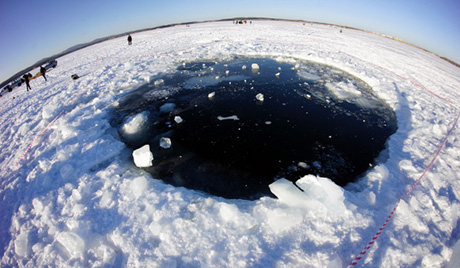
Taucher haben am Grund des Tschebarkulsees im Gebiet Tscheljabinsk in Russland, wo der Meteorschauer verzeichnet wurde, mehrere Trichter entdeckt, in denen sich vermutlich größere Meteoritenteile befinden können. Allerdings konnte der Meteorit wegen der drei Meter dicken Schlickschicht nicht gesehen werden.
Am 28. Februar wird ein Spezialisten-Team aus Jekaterinburg eine magnetische Untersuchung des Seegrundes unternehmen, mit deren Hilfe die tatsächliche Größe der Bruchstücke bewertet werden kann.
Der Meteorschauer wurde am 15. Februar in fünf Regionen Russlands registriert. Infolge des Meteoriten-Absturzes wurden mehr als 1.500 Menschen betroffen.
Quelle: Stimme Russlands
-
Update: 1.03.2013

Forscher aus Moskau und Nowossibirsk haben die Primärforschung der Splitter des Tscheljabinsk-Meteoriten beendet und erklärt, dass derartige Meteoriten bisher nie auf dem russischen Territorium entdeckt worden waren.
Der Meteorit erfolgte anhand der Rasterelektronenmikroskope und eines Chromatographen und Massenspektrometers. Es wurde festgestellt, dass der Meteorit ein gewöhnlicher Chondrit mit einem sehr niedrigem Eisengehalt aber mit relativ großen Chondren ist. Forscher vermuten, dass diese Angaben helfen werden, die Abläufe in den frühen Phasen der Entwicklung des Sonnensystems zu verstehen.
Quelle: RIANOVOSTI
.
Update: 14.03.2013
.
Beim Meteoriten-Niedergang im Februar am Ural haben es nach Angaben der russischen Wissenschaftsakademie etwa 1000 Tonnen meteoritischer Substanzen und damit nur zehn Prozent der Masse dieses Himmelskörpers bis zu Erdoberfläche geschafft.
Der Rest sei zu Staub zerborsten und habe sich in der Atmosphäre zerstreut, teilte Erik Galimow, Direktor des Wernadski-Instituts für Geo- und analytische Chemie an der Russischen Akademie der Wissenschaften, am Donnerstag mit. Das Anfangsgewicht des Meteoriten werde auf 10000 bis 18000 Tonnen und sein Durchmesser auf 17 bis 20 Meter geschätzt. Etwa 1000 Tonnen davon hätten die Erdoberfläche erreicht. Die Wissenschaftsakademie habe eine Suchmannschaft ausgeschickt, die etwa drei Kilo Meteoritensubstanz gefunden habe.
Die Meteoritenteile seien in einem 100 bis 150 Kilometer langen und 20 Kilometer breiten Landabschnitt niedergegangen, erzählte Galimows Kollege Dmitri Bajukow, an der Expedition teilgenommen hatte. Er hofft, dass das Gros der Meteoritenteile gefunden werde, nachdem der Schnee geschmolzen sei.
Der Leiter des Meteoritik-Labors Michail Nasarow schätzt die Energie, die bei der Explosion des Meteoriten freigesetzt wurde, auf 500 Kilotonnen. Doch auf die Stadt Tscheljabinsk, über der der Brocken explodierte, sei davon höchstens eine Kilotonne entfallen.
Ein Meteorit war am 15. Februar am Ural in der Atmosphäre eingetreten und explodiert. Durch die Wucht der Druckwelle zerbarsten tausende Fenster, Türen wurden eingedrückt. Etwa 1200 Menschen wurden durch Glassplitter verletzt.
Quelle: RIANOVOSTI








